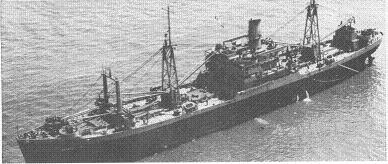![]() The Pacific War Online Encyclopedia
The Pacific War Online Encyclopedia
|
| Previous: C2 Class, Japanese Submarines | Table of Contents | Next: C3 Class, Japanese Submarines |

C2-S configured as Navy auxiliary. U.S. Navy photo from pub. ONI-54 A
| Tonnage | 6085 gross register tons 8794 deadweight tons |
| Dimensions | 459'6" by 63' by 25'9" 140m by 19.2m by 7.8m |
| Maximum speed | 15.5 knots |
| Complement | 124 |
| Machinery |
1-shaft General Electric geared
turbine (6000 shp) 2 boilers |
| Bunkerage | 1982 tons fuel oil |
|
Range |
12,000 nautical miles (22,000 km) |
| Cargo | 562,849 cubic feet (15,938 m3) |
The Maritime
Commission
standard C2 cargo ships were modern designs adapted
for rapid production. Their design was standardized in 1938-1939
and they were intended to be a permanent part of the merchant fleet.
The ships had five holds, three forward of the
deck house and two to its rear. There were two forward cranes and one
rear crane to load and unload cargo through the large deck hatches.
Most had geared turbine machinery, but some were completed with diesel
engines to reduce competition for the scarce reduction gear.
A large number of variations on the basic C2-S design were built. These included a number of ships modified by the Navy as attack cargo ships, amphibious command ships, and other auxiliaries.
The C2s have been described as "the pride of the
Maritime Commission" and were arguably the most successful
non-emergency design. A total of 173 were built between 1940 and 1945,
at a cost of about $2.3 million for each unit of the basic Cs-S-AJ1
design.
References
American Merchant Marine at War (accessed 2007-12-29)
The Pacific War Online Encyclopedia © 2007, 2009, 2012 by Kent G. Budge. Index